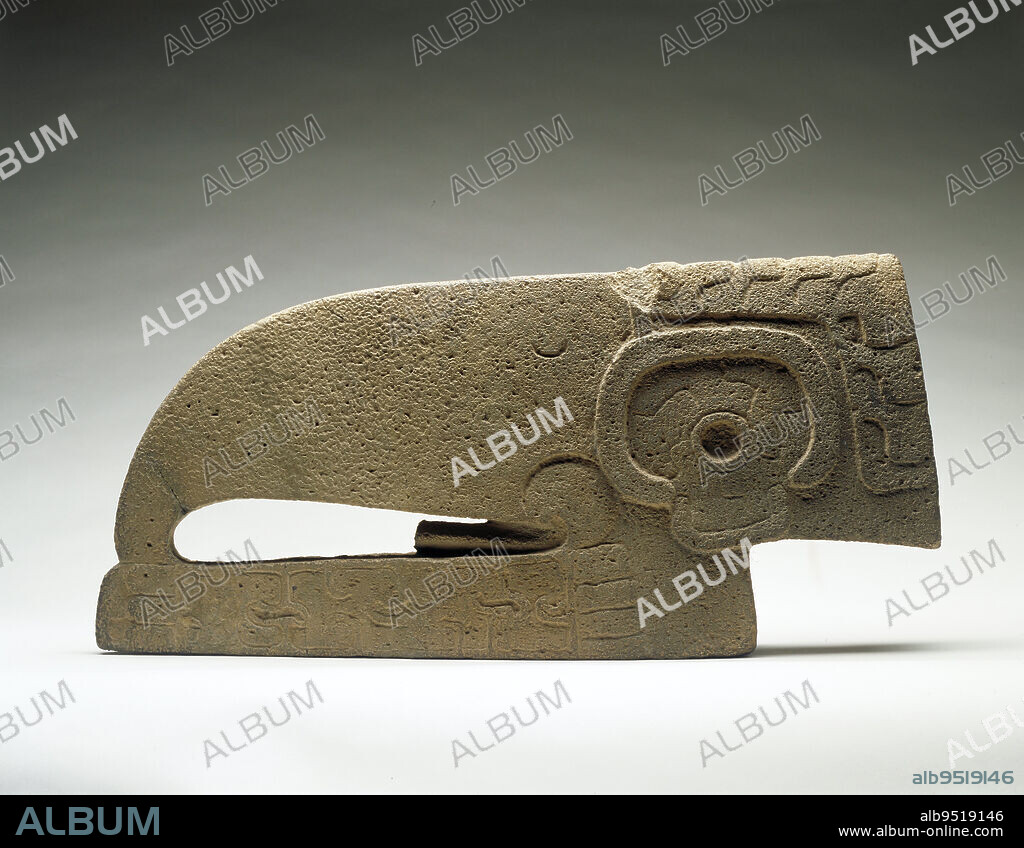alb9519146
Hacha, c. 600-900 CE, 10 x 21 x 2 1/2 in. (25.4 x 53.34 x 6.35 cm) (depth varied), Stone, 7th-10th century, Players of Mesoamerican ballgames wore u-shaped yokes around their hips made of cotton, wood, or leather to deflect the rubber ball in this no-hands team sport. Yokes made of carved stone were worn in opening and closing ceremonies for the game. Hachas were ornaments that attached to players' yokes during these ceremonies. The notch at the bottom of the hacha allowed it to sit atop the yoke encircling the player's hips. The ring around the eye of this bird hacha identifies it as a parrot or macaw, a possible reference to the supreme ball players known as the Hero Twins. They are the main characters of the Popol Vuh, the Maya creation story. The Popol Vuh is an important source of information on many ballgame-related objects throughout Mesoamerica.

|
Add to another lightbox |
|
Add to another lightbox |



Caption:
Hacha, c. 600-900 CE, 10 x 21 x 2 1/2 in. (25.4 x 53.34 x 6.35 cm) (depth varied), Stone, 7th-10th century, Players of Mesoamerican ballgames wore u-shaped yokes around their hips made of cotton, wood, or leather to deflect the rubber ball in this no-hands team sport. Yokes made of carved stone were worn in opening and closing ceremonies for the game. Hachas were ornaments that attached to players' yokes during these ceremonies. The notch at the bottom of the hacha allowed it to sit atop the yoke encircling the player's hips. The ring around the eye of this bird hacha identifies it as a parrot or macaw, a possible reference to the supreme ball players known as the Hero Twins. They are the main characters of the Popol Vuh, the Maya creation story. The Popol Vuh is an important source of information on many ballgame-related objects throughout Mesoamerica.
Credit:
Album / quintlox
Releases:
Model: No - Property: No
Rights questions?
Rights questions?
Image size:
5094 x 3957 px | 57.7 MB
Print size:
43.1 x 33.5 cm | 17.0 x 13.2 in (300 dpi)
Keywords:
600-900 CE • 7TH-10TH CENTURY • ARA • ATTACHED • AXE, CEREMONIAL • BACKSIDE • BALLGAME-RELATED OBJECTS • BIRD HACHA IDENTIFIES • BOTTOM • BUTT • CARVED STONE • CEREMONIAL AX • CEREMONIAL AXE • CEREMONIES • CLOSING CEREMONIES • COTTON • DECOR • DECORATION • DECORATIONS • DECORATIVE • DEFLECT • DEPTH VARIED • EYE • EYEBALLS • EYES • GAME • HACHA ALLOWED • HACHA • HACHAS • HERO TWINS • HIPS • IMPORTANT SOURCE • INFORMATION • LEATHER • MACAW • MAIN CHARACTERS • MAYA CREATION STORY • MESOAMERICA • MESOAMERICAN BALLGAMES WORE U-SHAPED YOKES • MESOAMERICAN • NO-HANDS TEAM SPORT • NOTCH • OPENING • ORNAMENT • ORNAMENTATION • ORNAMENTS • PARROT • PLAYER'S HIPS • PLAYERS' YOKES • PLAYERS • POPOL VUH • POSSIBLE REFERENCE • RING • ROCK • ROCKY • RUBBER BALL • SIT ATOP • STONE • STONES • SUPREME BALL PLAYERS • WOOD • WORN • YOKE ENCIRCLING • YOKES
 Pinterest
Pinterest Twitter
Twitter Facebook
Facebook Copy link
Copy link Email
Email

